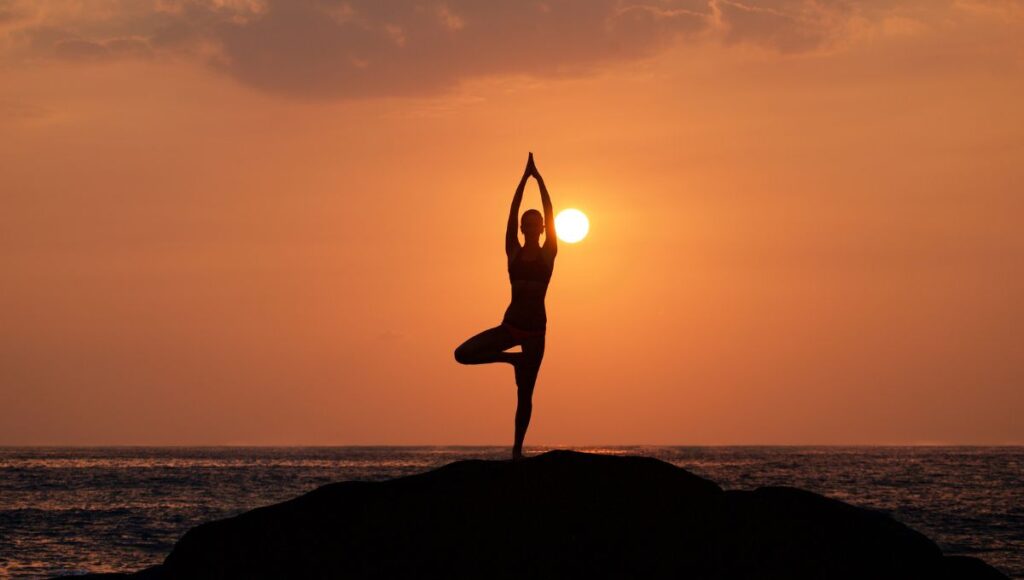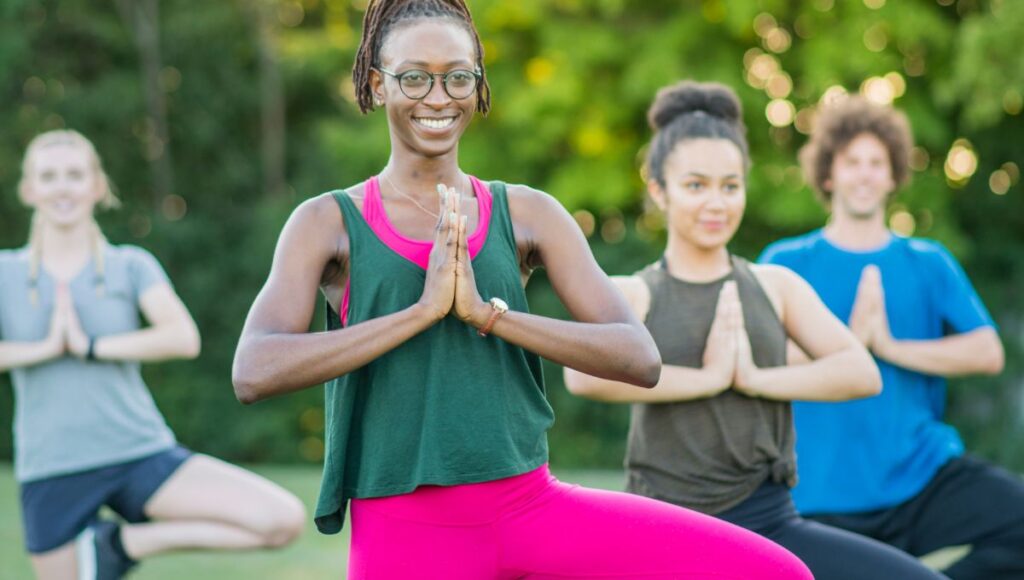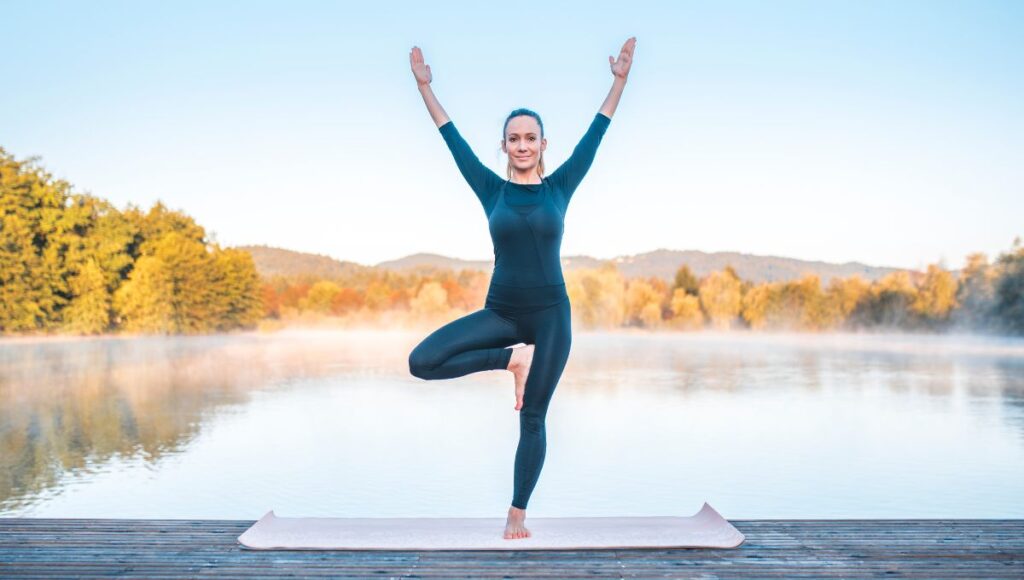
Tree Pose Yoga: Tips, How To & Common Mistakes
Tree pose yoga, also known as Vrikshasana in Sanskrit, is a fundamental posture that originates from the ancient practice of yoga. This pose embodies the grace and strength of a tree, allowing practitioners to find balance, stability, and focus in both body and mind.
It is a standing pose that may appear simple at first glance, but don’t be fooled by its apparent simplicity – it requires concentration and engagement of many muscles.
Finding your center of gravity while standing tall like a tree can help foster a deep connection with oneself and the surrounding environment. Tree pose invites us to ground our roots firmly into the earth while reaching upward towards the sky. Like an actual tree swaying gently in the breeze, this posture teaches us to be flexible yet resilient in the face of life’s challenges.
The beauty lies in its versatility – it can be performed anywhere you find yourself standing upright!
We’ll look at:
- What Muscles Are Involved?
- Step-By-Step Instructions
- Variations
- Common Mistakes
- Beginner’s Tips
What Muscles Are Involved?
When it comes to tree pose yoga, you might think it’s all about balance and stability. And while that’s definitely true, there’s more going on beneath the surface – specifically, in your muscles! Tree pose engages several key muscle groups, helping to build strength and improve overall body control.
One of the primary muscles involved in tree pose is the quadriceps. These powerful muscles are located in the front of your thighs and play a crucial role in extending your knee joint.

As you stand tall in tree pose, your quadriceps contract to stabilize your leg and keep it straight. This engagement not only strengthens your quads but also improves their endurance over time.
Another muscle group activated during tree pose is the glutes. These are the muscles located in your buttocks that help with hip extension and rotation.
In tree pose, when you lift one foot off the ground and place it on the opposite inner thigh or calf, your glutes kick into action to maintain stability and prevent any wobbling. Strong glutes not only provide a solid foundation for balance but also contribute to a toned posterior.
The core muscles are particularly engaged as they work together to support an upright posture during this standing balance posture.
The deep abdominals like transverse abdominis help stabilize the pelvis while the obliques help with rotational control as you maintain proper alignment in tree pose.
So, while practicing tree pose may seem like a simple act of standing on one leg with a lifted foot pressed against another leg, it actually involves multiple muscle groups working cohesively to enhance both physical strength and stability throughout your entire body!
By regularly practicing this pose, you can gradually increase muscular endurance, improve balance coordination, and enjoy greater overall physical well-being.
As you focus on maintaining stability within this posture for an extended period of time, you cultivate mental resilience and focus that can translate into other aspects of your life off the yoga mat. Tree pose is a remarkable yoga posture that embodies gracefulness and poise while building strength from within.
It challenges both physical balance and mental concentration simultaneously.
Step-By-Step Instructions
To perform the tree pose, start by standing tall with your feet hip-width apart and your arms relaxed at your sides.
Take a deep breath to center yourself and find your balance. Shift your weight onto your left foot, grounding it firmly into the ground.
Once you feel stable, lift your right foot off the ground and place the sole of your right foot against the inside of your left thigh.
If you’re having difficulty reaching or maintaining balance, you can also place it on your calf or ankle.

Engage your core muscles to help maintain stability and lengthen through the spine. With a gentle smile on your face, bring both hands together in front of your chest in a prayer position (known as Anjali mudra) or extend them overhead like branches reaching towards the sky.
Imagine yourself as a majestic tree firmly planted in the earth.
For beginners, it’s common to wobble or lose balance when attempting this pose. Don’t worry; it’s all part of the process!
You can use a wall or sturdy piece of furniture for support until you feel more confident. Remember to keep breathing deeply throughout each step – inhaling strength and exhaling any tension or doubt.
Now that you are rooted like a tree on one leg, focus on finding a gaze point in front of you. Fixating on this point will assist in enhancing concentration and stability. The act of focusing on one point or drishti helps redirect our attention inward, inviting a sense of mindfulness that extends beyond just this particular pose.
Stay in this position for 5-10 breaths, gradually working towards holding it for longer periods as you progress. To release from tree pose gracefully, gently lower the lifted leg back down to meet its counterpart.
Shake out any tension from both legs before repeating on the other side.
The more often you incorporate tree pose into your yoga routine, the stronger and more balanced you will become over time. So embrace this grounding stance as if embodying nature itself – sturdy yet flexible like a resilient tree standing tall amidst life’s challenges.
Variations
Here are some variations that I like to include in my classes:
1. Extended Tree Pose
One popular variation of the tree pose is the extended tree pose, which challenges your balance and stretches your entire body.
To do this variation, start in the traditional tree pose by standing tall with your feet together and hands on your hips.
Once you have found your balance, slowly raise one leg and place the sole of your foot against the inner thigh of the opposite leg, just like in the regular tree pose. However, instead of stopping there, extend both arms straight above your head, palms facing each other.
This added extension increases the intensity of the pose and engages more muscles in your core and upper body – it’s my personal favorite!

2. Twisted Tree Pose
The twisted tree pose adds a delightful twist to this already graceful posture by incorporating a gentle spinal rotation.
Begin by standing with your feet together and hands on your hips in a regular tree pose stance.
Once you have established stability, bring one knee up as usual and place the foot on either the inside or outside of your standing leg’s thigh. Next, lift both arms straight up towards the sky and then bring them down to rest alongside each other at chest level with palms pressed together in a prayer position (Anjali Mudra).
Now gently twist your torso towards the bent knee side while keeping both hips facing forward.
This twist helps to improve spinal mobility while strengthening core muscles.
3. Floating Tree Pose
For yogis seeking a challenge, floating tree pose takes balance to new heights — literally!
Start by coming into a standard tree pose on one leg with palms pressed together at heart center. Once you feel grounded and centered, gradually begin to lift both arms overhead while simultaneously lifting the foot away from resting on the thigh, so you’re using your muscles to hold it up.
If you can, you might want to try and extend that leg out long, to the side of the body – maybe even to hip height or higher if possible!
Maintain steady breath control as you find stability within this dynamic balance posture.
Each variation offers unique benefits, such as increased strength, flexibility, and improved focus. So go ahead and experiment with these variations to add excitement and diversity to your yoga practice!
Common Mistakes
Feet & Toes
One common mistake that many people make when attempting the tree pose is placing too much weight on the toes or the outside edges of their feet. This can lead to instability and a loss of balance.
It’s important to distribute your weight evenly across the entire foot, grounding through all four corners – the base of the big toe, base of the pinky toe, inner heel, and outer heel.
Imagine roots growing from your feet into the ground, providing a strong foundation for your tree.
Core Engagement
Another mistake beginners often make is forgetting to engage their core muscles while holding tree pose. Your core acts as a stabilizer in balancing poses like this one.

When you activate your abdominal muscles by gently drawing your navel toward your spine, it helps to center and anchor your body, making it easier to maintain both balance and alignment throughout the pose.
Beginner’s Tips
1. Find Your Balance
As a beginner attempting the tree pose, finding your balance can be quite challenging.
To help with this, start by practicing near a wall or using a chair for support.
Stand tall with your feet together and slowly shift your weight onto one leg. Engage the muscles in your standing leg to stabilize yourself. Keep your gaze fixed on a point in front of you to maintain balance.
If you feel wobbly, don’t be discouraged – it’s all part of the process!
2. Engage Your Core
While tree pose primarily targets your legs and hips, engaging your core is crucial for stability and alignment.
Imagine drawing up from the pelvic floor muscles towards the navel, gently activating the deep abdominal muscles without holding tension in the chest or shoulders. This engagement will provide a solid foundation and allow you to find more ease while holding the pose.
3. Experiment with Foot Placement
Initially, placing your foot high on the inner thigh might seem unattainable due to lack of flexibility or balance issues.
Don’t worry; there are variations that suit different levels of experience!
For beginners, placing the foot just above or below the knee can provide greater stability until you develop strength and confidence in maintaining proper alignment higher up on the inner thigh.

4. Utilize Props if Needed
If finding balance is still challenging even with support from a wall or chair, don’t hesitate to use props like blocks or straps as aids during tree pose practice!
Placing a block under your bottom hand while performing tree pose against a wall can offer additional stability and support until you gain strength in your standing leg muscles.
5. Breathe and Relax
One common mistake beginners make is holding their breath throughout challenging poses like tree pose due to the focus required for balance.
Remember to take deep, steady breaths while practicing.
This will not only help you stay calm and focused, but it also oxygenates your muscles, leading to greater stability and relaxation.
Conclusion
By engaging the muscles of the legs, core, and feet, this pose helps to improve stability, posture, and overall body awareness.
Incorporating tree pose into your regular yoga routine can have profound effects on your physical and mental well-being. As you stand tall like a grounded tree with branches reaching towards the sky, embrace the sense of rootedness within yourself.
Feel the strength flowing through your body as you find balance amidst life’s challenges.
So let us all take a moment to pause, breathe deeply, and appreciate the beauty of this ancient practice that connects us to our bodies and nature itself.
With dedication and practice, may tree pose yoga help us find stability in an ever-changing world, foster inner strength during challenging times, and remind us that growth is always possible if we remain rooted in our intentions.





